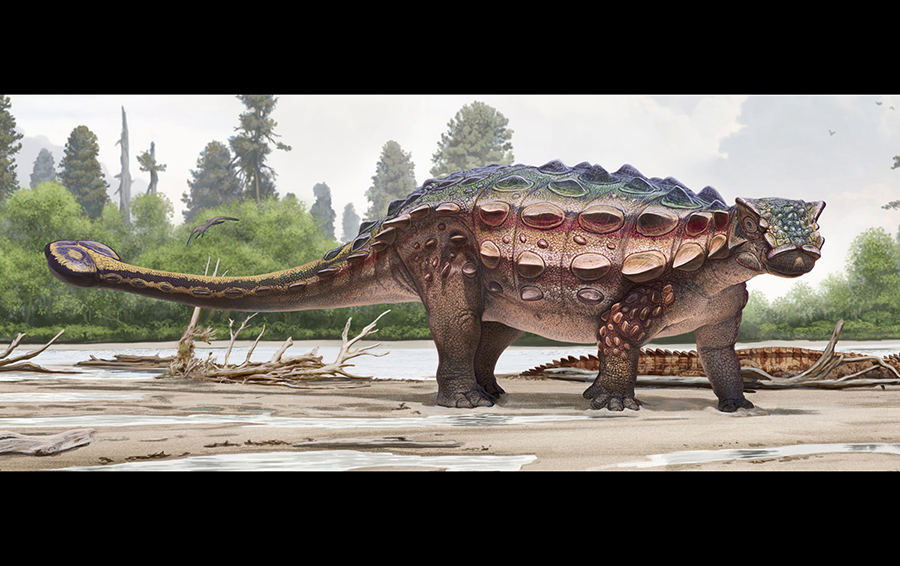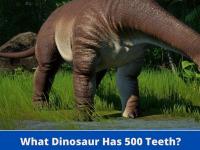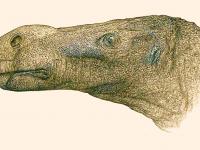Akainacephalus Johnsoni Comes Home to Kane County

Akainacephalus johnsoni comes home to Kane County.
A new species of dinosaur named Akainacephalus johnsoni has been discovered and announced in the Kaiparowits Formation of Grand Staircase-Escalante National Monument, where it was found in Kane County. The find is revealing new details about the diversity and evolution of this group of armored dinosaurs. This area of Kane County has yielded a high number of dinosaur discoveries, and there is a need and local desire to develop a facility and museum at the Kanab Center, a community center building to house and showcase the fossils found in the region.
Governor Herbert will be in attendance at the Grand Staircase-Escalante National Monument BLM Visitor Center in Big Water Sept. 11 at 12:40 p.m. to kick off the announcement of a partnership with Kane County and the BLM to develop exhibit space at the Kanab Center to display these exciting finds.
This is the 14th recently named dinosaur discovery from the area, and it is anticipated that a rich future of scientific research in the paleontology field continues.
The BLM regularly works with universities and researchers on these world-renowned unique discoveries. Currently, the Utah Museum of Natural History at the University of Utah houses many of the discoveries, and this effort seeks to augment these displays in a museum for the local population of the Kanab area and for the over 4 million travelers who visit the area each year.
Akainacephalusis johnsoni is the most complete Late Cretaceous ankylosaurid dinosaur discovered from Utah and the southwestern U.S., and is distinguished by a number of unique features, including spikes and cones of the bony exterior covering the head and snout. The dinosaur is part of a growing number of new dinosaur discoveries over the past 15 years demonstrating the incredible diversity of animals and plants living on Laramidia between 80 and 75 million years ago. One of the most exciting conclusions from this work highlights nearly every species of dinosaur discovered in Grand Staircase-Escalante National Monument is new to science, and Akainacephalusis johnsoni is no exception.
Since 2005, 14 new species of dinosaurs have been named from the Kaiparowits Plateau region: Hagryphus giganteus, Gryposaurus monumentensis, Nothronychus graffami, Diabloceratops eatoni, Utahceratops gettyi, Kosmoceratops richardsoni, Teratophoneus curriei, Nasutoceratops titusi, Talos sampsoni, Lythronax argestes, Machairoceratops cronusi, Adelolophus hutchisoni, Acristavus gaglarsoni, and most recently Akainocephalus johnsoni. That’s an average of slightly more than one per year, which is as high a rate of discovery of new dinosaurs anywhere else in the world. Several more discoveries will be published or submitted within the next two or three years, including a new armored dinosaur, two new horned dinosaurs, a new dome-headed dinosaur (Pachycephalosaur), a tiny new plant eater (Hypsilophodont), a new species of Hadrosaur, and possibly a new Tyrannosaur.
Much of the research is coordinated through Alan Titus, a Grand Staircase-Escalante National Monument paleontologist.
“We’ve also found some pretty bizarre non-dinosaur animals including six-foot-diameter lake turtles, armored giant tortoises with eggs preserved inside them, 35 foot-long alligators, and land-dwelling crocodiles,” Titus said. “The richness of fossil species in southern Utah appears to be higher than elsewhere in North American (at the same time), and it seems the place was an ecological paradise with a warm tropical climate and plentiful rain. These finds are changing how we see the dinosaur world, indicating it was more diverse and complex in North America than previously thought.”
The Kaiparowits Plateau is truly one of the paleontological wonders of the world right now and certainly is one of the most exciting frontiers for dinosaur research.
“So few people know about the discoveries because there is no place outside of Salt Lake City to see all these exciting finds on display,” Titus said. “Because so many larger animals have now been, or soon will be, named, it is high time for visitors to southern Utah have a place where they can experience the same wonder and awe that to date has largely only been felt by the specialists who make these discoveries.”
Full mounted skeletons of the great beasts that once lived in southern Utah during the zenith of the dinosaur age would be an amazing asset to the area and could potentially serve as a major economic engine, potentially attracting tens of thousands of visitors.
Source: http://suindependent.com








